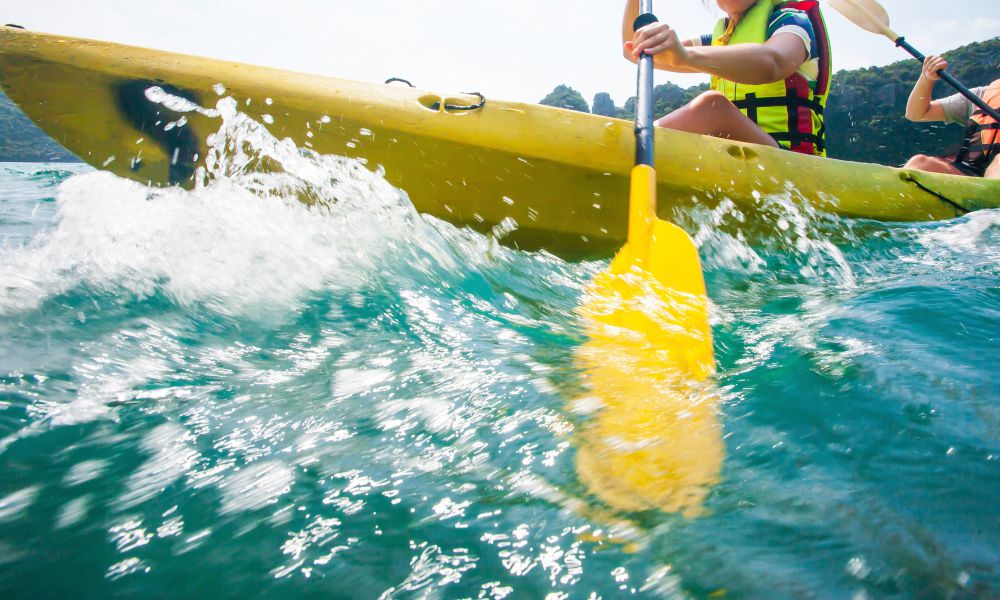Kayaking is an extremely popular way to enjoy the great outdoors, be around nature, and let off some steam. What you might not know is that it can also serve as a great workout.
According to Harvard Health Publications, a person weighing 150lbs will burn roughly 340 calories per hour while kayaking, which equates to roughly 170 calories every 30 minutes.
In this quick article, we’re going to take a closer look at how many calories kayaking burns, as well as the various health benefits it can offer.
How Many Calories Does Kayaking Burn
Does Kayaking Burn Calories?
The amount of calories you burn during kayaking depends on a variety of factors, meaning that there is no one-size-fits-all rule, however, there are some general ranges that apply.
The main factors which influence how many calories you’ll burn while kayaking are:
- Weight
- Age
- Physical composition
- Effort
A person who weighs more will burn more calories while kayaking than one who weighs less, simply because a heavier body requires more energy, and calories are burned through the expenditure of energy.
For example, while a 150lb person would burn roughly 170 calories during 30 minutes of kayaking, a person weighing 125lbs would burn 150 calories in the same amount of time. Going the other way, a 185lb person would burn approximately 210 calories.
Your age will also affect how many calories you burn while kayaking. The older you get, the slower your metabolism becomes because your body does not require as much energy. So, as a general rule, you will burn slightly fewer calories the older you are.
A 20-year-old male would burn roughly 170 calories (depending on their weight) from 30 minutes of kayaking, while a 40-year-old male would burn around 160 doing the same thing for the same length of time.
In terms of physical composition, this generally applies to how much muscle mass you have. In simple terms, the more muscle you have, the more calories you’ll burn, as they require more energy to move. Muscle requires three times more energy than fat.
Of course, the amount of effort you put into kayaking will also play a part in how many calories you burn while doing it. The more rigorous the kayaking, the more calories you’ll burn.
What muscles does kayaking work?
As you’re sitting down while kayaking, it doesn’t provide much of a workout for your legs, however it’s an excellent way to work your entire upper body.
Here are the main muscles worked while kayaking:
- Arms (biceps, triceps, forearms)
- Back (lats, traps)
- Shoulders (deltoids)
- Chest (pectorals)
- Core (abs, obliques)
To perform the rowing motion required for kayaking, you’re transferring weight and energy from your lats into your deltoids to bring the oar forward, then using your back, arms and chest to pull the oar back through the water.
As you twist to row on the other side of the kayak, you’re working your core muscles – the abdominals and obliques. The sustained rhythm of these movements mean these muscle groups are constantly being worked, making kayaking an effective workout for them.
Does kayaking help you lose weight?
As with any form of exercise, kayaking on its own can help you lose weight, but it depends on your lifestyle alongside it. You will lose weight when the number of calories you consume through food and drink is lower than the number you burn through exercise and your basal metabolic rate (the amount of calories your body naturally burns on its own, even if you’re doing nothing).
As outlined above, kayaking can burn a significant amount of calories, particularly when done for longer periods, and so can be an effective way of losing weight when coupled with an active and healthy lifestyle.
What’s more, it is an enjoyable pastime and can often not even feel like a workout, making it a sustainable form of exercise that is unlikely to get tiresome. As such, it can become a staple of your routine and help you lose weight in the long run.
Does kayaking build strength?
Like losing weight, the question over whether this activity can build strength very much depends on your current physical fitness. If you lift heavy weights regularly and already have a high level of strength, kayaking is unlikely to add much to this.
However, for most people the exercise of continuously rowing through water will sufficiently work their muscles to, at the very least, maintain the strength they already have. As so many different muscles are being worked for an extended period of time with little rest, your body can build strength.
The water acts as a form of resistance, meaning your upper body is working harder to keep the kayak moving. Resistance training has also been proven to improve a person’s basal metabolic rate, enhancing the potential for losing weight and burning more calories.
Again, this would need to be supplemented with a suitable lifestyle, more specifically a diet high in protein to promote muscle growth and aid repair.
Once you have been kayaking for a while, your body will have adapted to the workout and you’ll find that it is easier than it once was. At this point, if you want to build strength you should change an aspect of your sessions, such as the amount of time spent, or the distance you travel.
This is called progressive overload and is the process of making your physical activity gradually more challenging over time to ensure your gains in strength or weight loss do not plateau.
What are the other health benefits of kayaking?
If you’re at it for an extended period of time, kayaking will keep your heart rate elevated, meaning it can help improve your cardiovascular fitness.
Another key benefit of the activity that is sometimes overlooked is how much of a positive impact it can have on your mental health. Aside from the endorphins released from the physical exertion, spending time in nature and doing something enjoyable can be hugely beneficial to your overall wellbeing.
It’s also a very adaptable form of exercise; you can increase or decrease the difficulty depending on how your body is feeling. With a lot of energy, you could keep up a high speed and produce a tough workout. Alternately, if your body is feeling more tired, you can maintain a slower pace, while still working your muscles.
Final thoughts
You can burn anything between 160 to 220 calories for every 30 minutes of kayaking, though just how many you burn depends on a variety of factors. To accurately determine this number, you need to take into account your age, weight and physical composition.
Of course, different sessions on the water will produce different results depending on the amount of effort you put in. One of the main attractions of kayaking is that it blends strength and cardio training, helping you lose weight and build muscle at the same time.
It’s also an extremely enjoyable form of physical activity – most people do it for fun, rather than as a workout! This makes it a sustainable form of exercise that can have a positive impact on your mental health, as well as keeping you from feeling demotivated.

